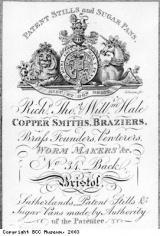Local Traders
Most merchants who put money into the slaving voyages had a wide range of other trading interests. Edward Colston was a Bristol-born but London-based slave trader. He also traded in dried fruit and wine from the Mediterranean area, and sugar. Thomas Freke, a Bristol slave trader who managed 14 slaving voyages, had investments in land, ships and glass. Grocers like Michael Miller were commonly found amongst slave ship investors.
Some merchants might not invest in the slaving voyages directly. Instead they might supply trade goods to the slave-ship agent , who would trade them in West Africa. In the early 1700s Bristol merchants supplied slave-ship agents with many of these goods, particularly brassware, gunpowder and lead shot for guns.
The Bristol brass manufacturing firm Richard and Thomas Hale supplied trade goods for the 1787 voyage of the Bristol slave ship the Fly. They supplied ‘basons’ (bowls) made from a metal called pewter, brass kettles and ‘cast iron Barrs’. Thomas Hale is pictured here. The brothers joined the campaign against the Abolition of the slave trade, they were in favour of the trade and wanted it to continue.
The Bristol firm of Harford and Company supplied the slave trader James Rogers’ slave ship the African Queen with 23 boxes of copper rods in 1792. The copper rods, as well as iron bars, were used as a form of money on the West African coast. Another business, Richard Frank and Son of Bristol, sold china goods to one of James Rogers’ slave ships in 1777. Were and Bush, another Bristol firm, provided linen goods for a voyage under the same slave trader, Rogers, the following year.
The hardware shop run by Neville Bath in Redcliffe, in Bristol, sold a wide range of goods for domestic and industrial use. His catalogue listed ‘New invented Machines for warming Churches’ and ‘Squirrel collars and chains’. He also sold mouse traps, oyster knives, gardening tools, silver sugar tongs, tobacco boxes, silk fishing lines, knitting needles, gentlemen’s shaving sets, sheep shears and sandpaper. Amongst the toys, cutlery, guns and trinkets listed in his catalogue is also the entry pictured here for ‘Articles suitable to the African Trade’.





